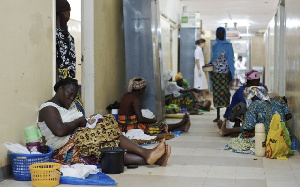Health News of Sunday, 20 December 2020
Source: Samuel Adadi Akapule
Leveraging on digitization to improve health care delivery in deprived rural settings: The story of U/E region
There is no doubt that technology is changing the landscape of service delivery across the globe and health care cannot be left behind. The World Health Organization (WHO) envisages the highest attainable standard of health as a fundamental right of every human being.
In spite of this, the standard of health care continues to vary across nations and this situation is likely to linger on for many more years if not decades. Access to quality healthcare for people in low and middle-income countries is becoming a major challenge.
Among the factors confronting healthcare delivery include poor physical access to health facilities, socio-cultural factors, poor quality care, affordability and acceptability of care by the people, weak health infrastructure and lack of adequately mix health workforce to meet health needs. The attendant result of this is the high morbidity, disability and mortality rates.
In Ghana for instance, the five regions of the north including the Northern, North East, Savanna, Upper East and Upper West Regions are the most affected when it comes to access to quality health care in the country all as a result of shortage of health professionals particularly doctors and nurses with specialties in the management of emergency and complicated health problems.
Health Challenges of UER
Speaking to the outgoing Upper East Regional Director of the Ghana Health Service (GHS), Dr Winfred Ofosu in an interview with the Ghanaian Times, he stated that although the region is yet to meet the national target of one doctor per 7,500 people in Ghana, the region which has a projected population of 1,302,718 in 2020 has had doctor population ratio improved from one doctor per 36,869 people in 2017 to one doctor per 18,459 people in 2019 under his leadership.
"Similarly, the nurse population ratio in the region has improved over the last three years from one nurse per 343 people in 2017 to one nurse per 316 people in 2019 surpassing the national target of one nurse per 450 people but again lack some of the specialities. The midwife situation per women in fertile age ratio is not different and has improved over the years from one midwife per 636 in 2017 to one midwife per 538 in 2019 performing better than the national target of one midwife per 700. Thus, the region is doing better with numbers of staff but the necessary specialists to handle severe and complicated cases remains a challenge’’, he stressed.
In terms of health infrastructure, the Regional Director observed that the region which was the first to pilot the Community-Based Health Planning and Services( CHPS) concept through the famous Navrongo Health Research Centre experiment now has a total of 523 (100%) demarcated CHPS zones; of which 363 (71.1%) are functional and 87.3% are CHPS with service delivery; 42 clinics, 8 hospitals of which 7 are district hospitals; 54 health centres; 4 maternity homes; one Regional hospital and 26 private facilities, all summing up to 508 health facilities in the region. Three of the hospitals were recently upgraded within the last three years from Health Centres into hospitals.
It is very important to also note that the Upper East region, apart from poor access to health care and inadequate skill mix of health professionals, also has attendant high maternal and perinatal morbidity and mortality as well as prone to frequent disease outbreaks such as cerebrospinal meningitis due to her location within the African meningitis belt.
Other health challenges include zoonotic diseases such as anthrax. In fact, it is important to note that before the introduction of the Digital Technology in the health delivery sector in the region, accurate data capturing and reporting, monitoring and evaluation for accountability purposes were problem.
Urgent diagnosis of some medical conditions, especially maternal emergencies as well as technical support for staff at the periphery in case of an emergency were really daunting challenges.
The Introduction and Impact of Digital Technology on Health Delivery in UER
It is very significant to stress that the above-mentioned challenges demanded very pragmatic, innovative and good leadership to effectively deliver quality health care services to the over 1, 302,718 population in the region.
One of the innovations adopted by the management of the Upper East Regional Health Directorate of the GHS led by the outgoing Regional Director, Dr Ofosu is the Digital Technology Concept.
When the Ghanaian Times contacted the Regional Directorate to find out about the impact of the Digital Technology on health delivery systems in the region, he indicated that since the deployment of the technology for use by all health facilities in the region, there has been an improvement in quality healthcare delivery and prompt diagnosis as well as management of emergency cases especially maternal and newborn conditions.
He told the Ghanaian Times that among the good things about the deployment of the technology is its telemedicine which uses information and communications technology (ICT) to connect staff at lower-level facilities including community health workers at the CHPS level to medical specialists via 24-hour teleconsultation centre at the Bolgatanga Regional Hospital.
"Through the use of the technology, Doctors, Nurses and Midwives in the teleconsultation centres are able to coach community health workers and advise on the treatment of their patients, helping them manage emergency cases and promptly refer those beyond their capacity thereby averting avoidable deaths and disabilities. To complement the teleconsultation centre, social media platforms are created for daily use. These include “WhatsApp group for referrals and quality of care, use of text messages, emails, Facebook account, and the weekly conference calls to discuss maternal and newborn quality of care issues’’, he disclosed
He mentioned that another digital technology that had been introduced is the mobile handheld ultrasound scan machines at the health centre and maternity units of hospitals which facilitates prompt diagnosis of emergency maternal conditions.
"In addition, e-tracker, an electronic transactional data capture tool is often deployed across the region at the CHPS and Health centre levels to improve the quality of data to ensure accountability. The deployment of digital technology in the region has not only strengthened the healthcare capacity and empowered community health workers to deliver effectively, but has also improved the quality of care, emergency care management, avoided unnecessary delays through prompt referrals as well as reducing transport time and costs for patients through the use of tricycle ambulances for translocation within the region from remote hard-to-reach areas of the region. As a consequence, the region has seen substantial improvement in health indicators over the last three years.’’, Dr Ofosu revealed.
“Digital health enables healthcare managers to make timely, evidence-based decisions and can reduce costs while improving overall quality of care. This situation offers exciting potential for advancing Universal Health Coverage with the region set to achieve 100% functional CHPS coverage by 2025 and achieving Sustainable Development Goal 3 which places emphasis on ensuring healthy lives and promoting well-being for all at all ages.”, he added.
Under the digital technology, some major hospitals including the Bolgatanga Regional hospital have gone paperless through electronic prescribing to reduce prescription errors and improved upon patient safety by allowing clinicians to send prescriptions electronically to the pharmacy for dispensing of medicines for treatment.
“Many serious medication errors can occur sometimes due to inability to read prescription correctly due to poor prescriber handwriting on paper but with the introduction of the information technology, this challenge has been eliminated’’., he stressed.
The out-going Regional Director who mentioned that the introduction of Electronic Health Records (EHRs) in replacing paper records at the health facilities in the region has been a game-changer for many healthcare professionals, added that through the digital technology, nurses and technicians are now able to input patient data such as vital signs, weight, test results among others into a central, digitized system to help to reduce waiting time of patients before seeing a clinician.
One thing is clear. It is a well-known fact that the digital technology has revolutionized virtually every aspect of our life and healthcare is no exception.
The Regional Director who commended the Novartis Foundation which is working with the GHS and the Ministry of Health on a roadmap to scale-up the technology, also lauded Millennium Promise Alliance, Earth Institute, Columbia University, the Ghana Ministry of Health, Ministry of Communication, National Health Insurance Agency, and Ambulance Service, St. Martin’s Hospital, Med Gate, Ericsson and Airtel for the promotion of telemedicine through the Digital Technology.
Whilst commending the management of the Upper East Regional Health Directorate of the GHS lead by the outgoing Regional Director, in tapping the Digital Technology for tackling the health challenges in the region, there is the urgent need for the remaining regions in the country, particularly the Northern, Upper West, Savannah regions to also adopt the technology to help confront the health challenges.
Entertainment










